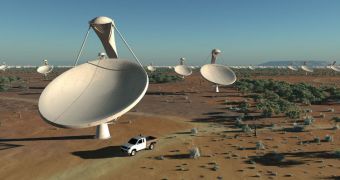The Square Kilometer Array (SKA) radio telescope will be installed both in Australia and South Africa, project managers announce. This will be the most sensitive radio installation ever developed, and will be used to investigate the Universe in more detail than ever before.
The announcement was made yesterday, May 25, and solves an issue that has plagued the project for some time. Scientists tried to determine which of the two locations was best suited for conducting radio astronomy, but eventually decided to install SKA dishes at both.
When the new radio telescope is completed, it will include 3,000 radio antennas, each 15 meters (50 feet) in diameter. Data collected by each individual dish will then be included in a stream of information that will exceed the current amount of data on the entire Internet by 200 percent daily.
IBM has been assigned with the nearly impossible task of creating a supercomputer center capable of handling the exascale (1 followed by 18 zeros) data influxes. The Netherlands Foundation for Research in Astronomy (ASTRON) sponsors the company with a $42 million grant for this effort.
Now that the site selection process is complete, project managers and engineers can move on with the actual design and construction phase of the telescope. The announcement was made by the Interim Director General of the SKA Organization, Michiel van Haarlem.
If everything goes according to current plans, the construction efforts will begin in 2016, and end as early as 2024. The project will cost an estimated $2 billion (1.5 billion euros), Space reports.
According to the SKA technical chart, the telescope will be around 50 times more sensitive than any other observatory today, and will be capable of conducting its surveys roughly 10,000 times faster too.
“The SKA will transform our view of the universe; with it we will see back to the moments after the Big Bang and discover previously unexplored parts of the Cosmos,” van Haarlem explains.
Some of the observatory's main science goals include observing dark matter and the ever-accelerating expansion of the Universe, studying the very nature and fabric of gravity, investigate how the first galaxies and stars formed, and so on.
Australia and South Africa will soon start to build the two SKA precursors – the Australian Square Kilometer Array Pathfinder (ASKAP) and the Karoo Array Telescope (MeerKAT). Once the large telescope is finished, both ASKAP and MeerKAT will be included in the project.

 14 DAY TRIAL //
14 DAY TRIAL //